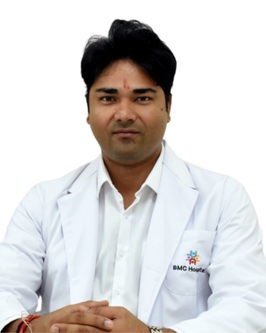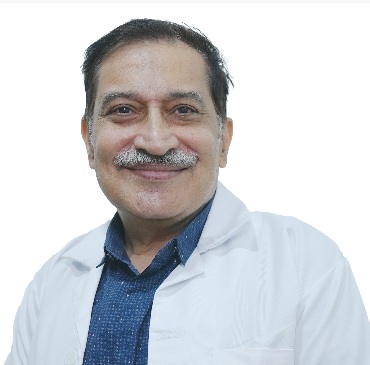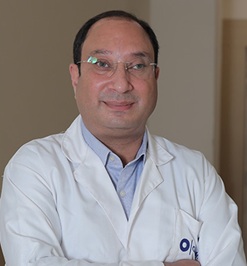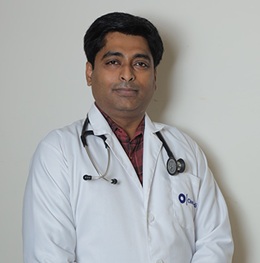Rotator Cuff Repair Surgery: Procedure, Purpose, Recovery
Dr. Prince Gupta

Treatment Duration
60 Minutes
------ To ------90 Minutes
Treatment Cost
₹ 1,10,000
------ To ------₹ 2,00,000

Table of Contents
You can check Rotator Cuff Repair Cost here.
What is rotator cuff repair surgery?
Rotator cuff repair surgery is a technique to address a torn rotator cuff tendon in the shoulder. It is a set of muscles and tendons that keeps the shoulder joint stable and allows for a wide range of motion. A tear in this crucial structure can cause significant pain, weakness, and limitations in daily activities.
This surgery aims to reattach the torn tendon back to the upper arm (humerus) bone. It can be a minimally invasive procedure performed arthroscopically or a more traditional open surgery. Rotator cuff repair surgery can alleviate pain, restore shoulder function, and improve quality of life.
Anatomy and Physiology
The shoulder joint is a vital part of the upper body and offers a remarkable range of motion and stability. To understand rotator cuff repair surgery, let's explore the basic building blocks of this part of the human body:
Ball and Socket Joint: The shoulder functions like a ball-and-socket joint. The ball, formed by the upper arm bone, fits into a scapula (a shallow socket in the shoulder blade).
Rotator Cuff: The rotator cuff, a group of four muscles and their tendons, forms a protective cuff around the shoulder joint. These muscles develop from the scapula and attach to the humerus, providing stability and strength.
Expert Doctors (10)
NABH Accredited Hospitals (10)


Who needs rotator cuff repair?
Rotator cuff repair surgery is a targeted intervention to address specific pathologies within the shoulder joint. The primary focus of rotator cuff repair surgery is to treat a tear within the tendons comprising the rotator cuff muscle group. These tears can significantly impact daily life, causing pain, weakness, and limiting movement in the shoulder. Tears can be:
Partial Tears: Involve a rip or fraying that only affects a portion of the tendon thickness. They may cause pain, weakness, and a catching sensation in the shoulder, particularly during specific movements.
Complete Tears: Involves complete separation of the tendon from the bone in the upper arm. They typically cause significant pain, weakness, and a noticeable loss of function in the shoulder.
It's important to note that rotator cuff repair surgery is not always the first line of treatment. Conservative management with physical therapy and medications is often attempted initially. Individuals who have undergone physical therapy and medication for several months but continue to experience the following rotator cuff tear symptoms should consider the surgery:
Difficulty, pain, and weakness when raising, lowering, or rotating their arm.
Popping, clicking, or crackling sounds when moving their arm in certain positions.
Shoulder pain that declines at night or when resting the arm.
Shoulder weakness and difficulty lifting items.
Benefits of Rotator Cuff Repair Surgery
Rotator cuff repair surgery can be a life-changing procedure for individuals suffering from chronic shoulder pain and weakness caused by a torn tendon. Following are some of the key benefits one might experience after a successful operation:
Reduced Pain: Surgery addresses the torn tendon, the root cause of the discomfort, allowing for pain-free movement and improved overall comfort.
Improved Shoulder Function: Regaining strength and flexibility in the shoulder joint is important for daily activities. Rotator cuff repair can restore the ability to perform regular tasks without limitations.
Enhanced Quality of Life: Chronic shoulder pain can significantly impact daily life. Rotator cuff repair surgery can improve the quality of life by addressing the underlying issue and promoting healing.
Before and on the Day of Surgery
Rotator cuff repair surgery can effectively address torn tendons in the shoulder. Effective preparation is essential for a smooth and successful procedure. Below are the key steps involved before, during, and after surgery:
Before Surgery
During Surgery
Rotator Cuff Repair Procedure
Open surgery or arthroscopic rotator cuff repair are two main approaches for the surgery. The procedure choice depends on the severity and location of the tear, along with the surgeon's opinion.
Surgical Procedure
The type of surgery determines the specific steps involved. Here's a breakdown of each approach:
Open Repair Surgery: A larger incision is made directly over the shoulder joint to access the torn tendon. Surgeons can repair the tear using sutures and anchors to join the tendon to the bone. This approach might be necessary for complex tears or repairs involving additional procedures.
Arthroscopic Rotator Cuff Repair: This minimally invasive technique is used for smaller tears and utilises a camera (arthroscope) inserted through a small incision. The surgeon views the inside of the joint on a monitor and uses miniature tools to repair the tear with anchors and sutures.
Completion of Surgery
Once the tear is repaired, bone spurs are removed to create more space for smooth movement. The incisions are sutured with staples or stitches, and a sterile dressing is applied.
After Surgery Recovery
Recovering from rotator cuff repair surgery is gradual, typically taking up to 9 months. Below is what to expect at each stage of recovery:
In Hospital Recovery (Weeks 1-2)
After surgery, the immediate focus is pain management and protecting the repaired tendon. Depending on the condition, the patient is typically discharged within 48-72 hours of the surgery. The steps to be followed in the hospital are mentioned below:
Limited Arm Movement: Wear a sling to prevent strain on the shoulder.
Pain Management: Medications are prescribed to manage discomfort and inflammation.
Passive Range-of-motion Exercises: A physical therapist will guide the patient through gentle movements to improve joint mobility without straining the muscles. The exercises should begin from week 4.
At-home Recovery (Weeks 3-9+ Months)
From weeks 3-4, the patient will progress to active exercises to strengthen the muscles around the shoulder. The general recovery period after the surgery is 6-9 months. Physical therapy plays a vital role throughout recovery:
Weeks 3-4: Gentle active exercises to strengthen the muscles supporting the shoulder joint. A physical therapist will recommend exercises and weight limits.
Weeks 5-8: Exercises focus on improving strength without overloading the joint. Scar tissue formation is natural but can cause stiffness.
Weeks 9-12: Increased strengthening and regaining functional shoulder use. Physical therapy may incorporate exercises with light resistance bands or weights. Gradually resume light daily activities at home.
Months 4-6: Continue strengthening and regaining full range of motion in the shoulder. Gradually resume most daily activities, but avoid heavy lifting or strenuous tasks. With the doctor's approval, non-contact sports might be permissible for six months.
6 Months Onwards: With proper rotator cuff repair rehabilitation protocol, the patient should be able to resume most daily activities and sports without limitations.
Risks And Complications of Rotator Cuff Repair Surgery
As with any surgery, rotator cuff repair carries potential risks and complications. While uncommon, it's important to be aware of these possibilities before deciding on surgery:
Re-tear: After surgery, the repaired tendon could tear again, especially with larger tears or strenuous activity.
Stiffness: Scar tissue formation after surgery can limit the shoulder's range of motion. Diligent adherence to physical therapy is crucial to regain flexibility and prevent stiffness.
Infection: There's a slight chance of infection developing at the surgical site. Antibiotics are typically administered during surgery to minimise this risk.
Risk of Delaying Rotator Cuff Repair Surgery
Rotator cuff repair surgery isn't always the immediate answer for everyone. However, delaying surgery for a torn tendon can sometimes lead to more complex problems. Below are some potential risks associated with waiting too long to address a rotator cuff tear:
Muscle Wasting: Over time, a torn tendon can lead to weakness and atrophy (wasting) of the muscles surrounding the shoulder joint. This can make regaining strength and function after eventual surgery more challenging.
Arthritis Progression: A torn tendon can create instability in the shoulder joint, accelerating the development or worsening existing osteoarthritis. Early repair can help preserve joint health.
Increased Difficulty of Repair: In severe cases, delaying surgery can lead to a more complex tear pattern. It can make the repair process more challenging and potentially affect the long-term outcome.
Cost of Rotator Cuff Repair
As an effective treatment for torn tendons, the rotator cuff repair surgery price can vary depending on several factors. A table summarising the cost is included below for the reference:
Rotator Cuff Repair | Estimated Cost |
Minimum | ₹1,10,000 |
Average | ₹1,30,000 |
Maximum | ₹2,00,000 |
Takeaway
Rotator cuff tears can significantly impact your daily life. Rotator cuff repair surgery offers a potential solution for regaining shoulder function and reducing pain. This surgery addresses torn tendons within the rotator cuff muscle group. Early diagnosis and treatment are significant for optimal healing.
HexaHealth can help you make informed decisions. Our comprehensive platform connects you with highly-rated surgeons and healthcare facilities in your vicinity. From estimating the cost to the rotator cuff repair rehabilitation protocol, we will assist you throughout the process. Visit the HexaHealth website or app to find the specialist in your area and book an appointment.
Suggested Reads
| Shoulder Arthroscopy |
Shoulder Fracture Surgery |
| Shoulder Impingement |
Exercises for Frozen Shoulder |
Frequently Asked Questions (FAQ)
What is a rotator cuff tear?
It is an injury to one or more tendons within the rotator cuff muscle group, which helps stabilise and move the shoulder joint. These tears can occur due to overuse, ageing, or a sudden trauma.
What are the symptoms of a rotator cuff injury?
It is important to find the early signs of rotator cuff injury to adopt corrective measures. Below are some symptoms to keep an eye on:
Difficulty raising, lowering, or rotating the arm
Pain, especially at night or when resting
Weakness in the shoulder
Popping, clicking, or crackling sounds when moving the arm
What are the different types of rotator cuff tears?
There are generally two broad categories for rotator cuff tears. Following are those tears the should be acquainted with:
Partial Tear: When the tendon is partly torn but still attached to the bone.
Complete Tear: When the tendon is completely detached from the bone.
How rotator cuff tear is diagnosed?
The orthopaedics will run a series of tests to understand the situation. Diagnosis typically involves a combination of:
Medical History and Physical Examination: Discuss the symptoms and a physical assessment of the shoulder joint.
Imaging Tests: X-rays, ultrasound, or MRI scans to visualise the shoulder and identify the tear.
When is rotator cuff repair needed?
There are a bunch of reasons why rotator cuff repair surgery is needed. Following are the instances where surgery should be considered:
Persistent pain and weakness despite conservative treatment (physical therapy and medication) for several months.
Large or complete tears that significantly impact function.
Active individuals who desire a return to full activity level.
How is a rotator cuff tear repaired surgically?
For a rotator cuff injury, there are two main surgical approaches:
Open repair: A larger incision is made to directly access and repair the torn tendon with sutures and anchors.
Arthroscopic rotator cuff repair: A minimally invasive technique using a small camera and specialised instruments inserted through tiny incisions.
What is the recovery time after rotator cuff repair surgery?
Recovery is gradual and can take several months. For instance:
Six weeks for bones to heal
3 months to form a strong attachment to the bone
8-9 months for tendons to fully join the bone
What exercises are recommended during rotator cuff rehabilitation?
A physical therapist will design a specific exercise program as a part of the rehabilitation protocol. It may include:
Range-of-motion exercises to improve shoulder flexibility.
Strengthening exercises to build muscle strength and stability.
Scapular strengthening exercises to improve shoulder blade mechanics.
What are the potential complications of rotator cuff repair surgery?
Being a minimally invasive procedure, the chances of complications are rare. However, the following are the possible problems one may encounter:
Infection
Bleeding
Nerve damage
Stiffness
Consistent pain or weakness
Failure of the repaired tendon to heal properly
How long does it take to recover full-range motion after rotator cuff surgery?
Regaining full range of motion can take up to 9 months after surgery, depending on the severity of the tear and progress in physical therapy. For a speedy recovery, following the rotator cuff repair rehabilitation protocol is advised.
What factors can affect the success of rotator cuff repair surgery?
The success of rotator cuff repair surgery relies on several key factors. Following are some of the most significant influences:
The severity of the tear
Age and overall health
Following rehabilitation exercises diligently
Underlying medical conditions
Is physical therapy necessary after rotator cuff repair surgery?
Yes, physical therapy is crucial for regaining strength, flexibility, and full function in the shoulder. It helps ensure proper healing and reduces the risk of complications.
Can a rotator cuff tear heal without surgery?
Small tears may heal with conservative treatment like rest, medication, and physical therapy. However, larger tears or those causing significant pain and weakness often require surgery for optimal healing and regaining function.
How soon can I return to normal activities after rotator cuff surgery?
Returning to normal activities depends on the progress and the doctor's recommendations. Light daily activities can be resumed after a few months, while strenuous activities may take up to 9-12 months.
Are there any alternative treatments to surgery for a rotator cuff tear?
When having rotator cuff tear symptoms, non-surgical treatments are often attempted first. These may include:
Rest
Medication (pain relievers, anti-inflammatory drugs)
Physical therapy
Cortisone injection (to reduce inflammation)
What is the rotator cuff repair surgery price?
The rotator cuff repair surgery price ranges from ₹1,10,000 to ₹2,00,00 in India. However, this cost can vary based on various factors like surgical expertise, geographical location, and severity of the condition.
Is rotator cuff repair surgery covered under insurance?
Being a medically necessary procedure, rotator cuff repair surgery is often covered under insurance. It's crucial to understand individual plan details to determine the potential out-of-pocket costs associated with rotator cuff repair surgery.
More Treatment options
References
All the articles on HexaHealth are supported by verified medically-recognized sources such as; peer-reviewed academic research papers, research institutions, and medical journals. Our medical reviewers also check references of the articles to prioritize accuracy and relevance. Refer to our detailed editorial policy for more information.
- Rotator Cuff Repair [Internet]. www.hopkinsmedicine.org.

- Cleveland Clinic. Rotator Cuff Tear [Internet]. Cleveland Clinic. 2023.

- Rotator Cuff Surgery: A Timeline for Recovery [Internet]. Healthline. 2023 [cited 2024 May 6].

- Failed Rotator Cuff Repairs [Internet]. www.hopkinsmedicine.org. 2023.

- Rotator cuff surgery: What to expect, benefits, and recovery [Internet]. www.medicalnewstoday.com. 2021 [cited 2024 May 6].

- Mayo Clinic. Rotator cuff injury - Diagnosis and treatment - Mayo Clinic [Internet]. Mayoclinic.org. 2018.

- Rotator Cuff Tears: Frequently Asked Questions - OrthoInfo - AAOS [Internet]. www.orthoinfo.org. [cited 2024 May 6].

Last Updated on: 19 July 2024
Reviewer

Dr. Prince Gupta
MBBS, MS Orthopaedics, Fellowship in Arthroplasty, MCh Orthopaedics, Fellowship in Joint Replacement
18 Years Experience
Dr Prince Gupta is a well-known orthopaedic surgeon currently associated with Manipal Hospital, Gurugram. He has 18 years of experience in orthopaedics and worked as an expert in different cities of India. He has worked in many reputed h...View More
Author

Sparshi Srivastava
B.Tech Biotechnology (Bansal Institute of Engineering and Technology, Lucknow)
2 Years Experience
An ardent reader, graduated in B.Tech Biotechnology. She was previously associated with medical sciences secondary research and writing. With a keen interest and curiosity-driven approach, she has been able to cont...View More
Latest Health Articles























